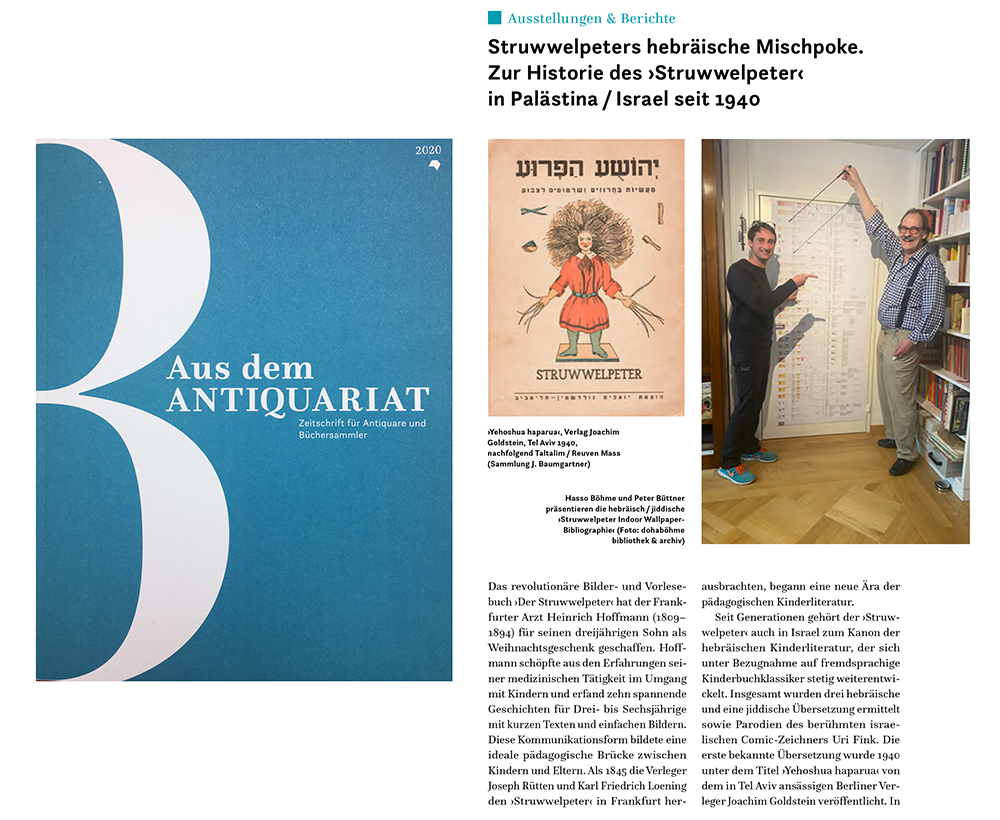Hasso and Dominique Böhme, photo by Fred Maro

About us:
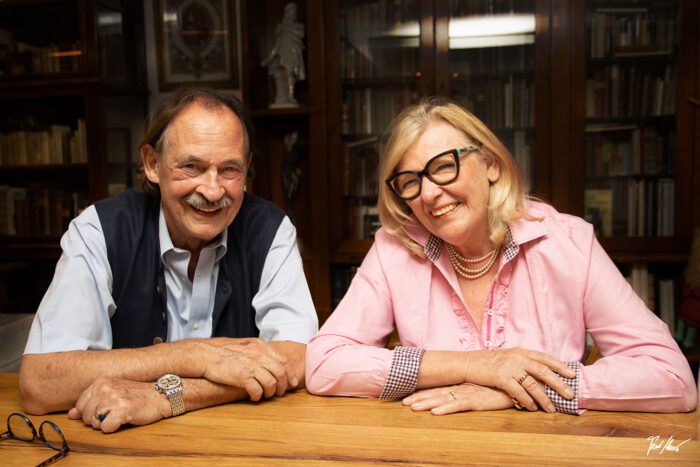
“dohaböhme library & archive”
Hasso and Dominique Böhme, Unterengstringen, Switzerland
Focal points of the collection: ABC picture books, Amor and Psyche and other Greek mythologies, Faust and Faustiads, Reineke Fuchs and fables, Struwwelpeter and Struwwelpetriades as well as other bibliophile rarities worth collecting.
Hasso Böhme’s passion for bibliophile collecting began in the 1970s. Since then, his collection has been growing steadily and is lovingly supported by his wife Dominique with her ABC book collection.
The “dohaböhme bibliothek & archiv” was founded by them in 2018 and has not only set itself the goal of collecting, but also of researching in the given subject areas.
In addition to trouvailles and rarities, the collection also contains sales editions of various titles in different languages and versions. Various types of adaptations, dedication copies, book fragments and autographs (e.g. contracts, letters and other documentation) as well as books that have been coloured, read, specially designed and sometimes translated by adults and children themselves.
The library has one of the most important Struwwelpeter collections in the world. It has already been able to produce remarkable research results. An important basis for book research is provided by a large amount of secondary literature in the library. The Faust collection and the Reineke Fuchs collection with its broad spectrum of fables date back to the 15th century.
The ABC book collection begins in the late 16th century and includes all possible languages and versions up to the present day.
News from our research library:
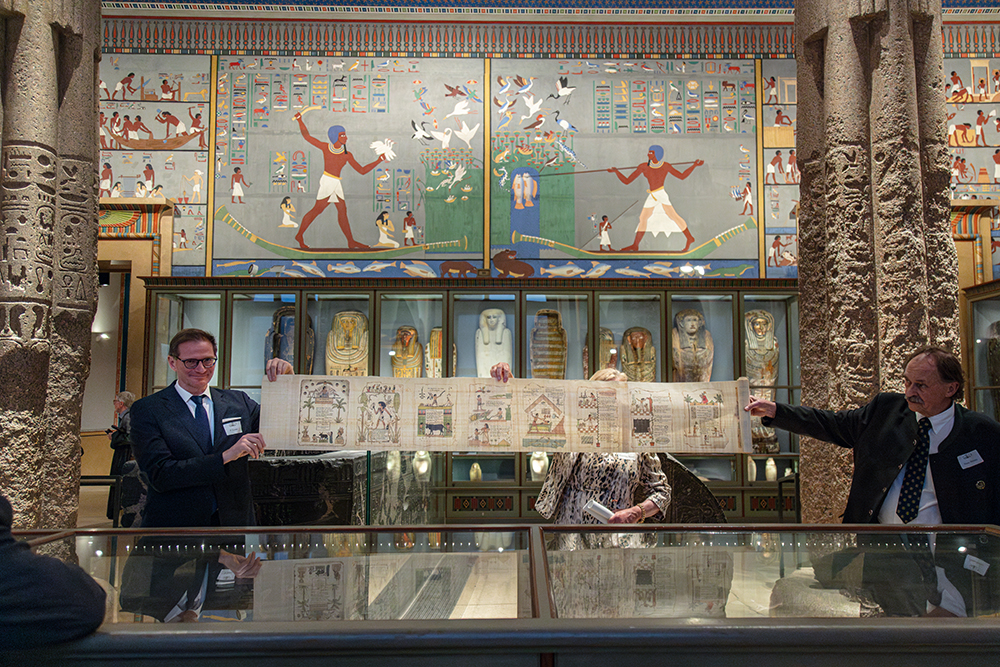
Presentation of the ‘Egyptian Struwwelpeter on papyrus’ (scroll excerpt of approx. 1.8 m) at the Kunsthistorisches Museum, Vienna on Wednesday, 23 April 2025
The bibliophile world premiere ‘The Egyptian Struwwelpeter on papyrus’ presented at the Kunsthistorisches Museum, Vienna on 23 April 2025
We can look back on a successful presentation of the bibliophile world premiere of the ‘Egyptian Struwwelpeter’ on a 4.5 metre long papyrus scroll.
Guests were welcomed in the foyer of the Kunsthistorisches Museum from 6.30 pm with introductory words from Hasso Böhme, Adelheid Hlawacek and Prof. Dr Ernst Fischer, Chairman of the Vienna Bibliophile Society. The presentation of the world première of the ‘Egyptian Struwwelpeter on papyrus’ was accompanied by drinks and snacks.
From 19:30 – 20:15 the guests were given two guided tours through the Egyptian-Oriental Collection of the Kunsthistorisches Museum.
At 8.30 pm, the event came to a pleasant conclusion in the foyer.
Further information on the history of the publication and the opportunity to order a numbered edition of the ‘Egyptian Struwwelpeter on Papyrus’ of 18 copies each in German and English can be found here.
The 48-page accompanying booklet to the papyrus roll with the extensive history of the ‘Egyptian Struwwelpeter’, CHF 18.00, EUR 20.00, can be ordered at info@doha-bba.com.
Impressions of this wonderful event can be found here. (Brochure in German)
We would like to thank the Kunsthistorisches Museum Vienna, Dr. Regina Hölzl, Director of the Collection and Hanna Schneck, Director of the Museum Library, as well as the organisers Adelheid Hlawacek and Prof. Ernst Fischer, Vienna Bibliophile Society.
April 29th 2025

Lecture “The immortal Struwwelpeter” on 13 November 2024 at the EOS Benz antiquarian bookshop, Zurich
‘Book Culture Zurich’ event series on Wednesday, 13 November 2024
Lecture ‘The immortal Struwwelpeter’
An inspiring evening at the antiquarian bookshop EOS Benz on Kirchgasse in Zurich!
‘Hasso Böhme’s lecture on the history of Struwwelpeter was not only exciting and informative, but also full of humour. Many thanks to the speaker for his fascinating insights! Our antiquarian bookshop was packed again, and afterwards everyone enjoyed a cosy get-together over a drink.’ Marcus and Trudi Benz, EOS Antiquariat Benz, Zurich
We would like to thank Trudi and Marcus Benz for this wonderful evening!
October 20th 2024

The “Egyptian Struwwelpeter” on Papyrus – Work in progress
Work in Progress
The story of the creation of the «Egyptian Struwwelpeter» from 1894 in Vienna as a papyrus roll realised in 2024 in Unterengstringen/Zurich.
To be continued!
October 15th 2024
The original «Egyptian Struwwelpeter» published by Gerold’s Sohn in Vienna in 1894.
On the left in German and on the right in English, one version for England and one for America.


Hasso Böhme with his 4.5 metre long papyrus scroll of the “Egyptian Struwwelpeter”
World premiere
The first publication of “Der Aegyptische Struwwelpeter” from 1894, reproduced on original “two-layer” papyrus in a 4.5 metre long papyrus roll.
The book “Der Struwwelpeter” served as the conceptual model for the original book “Der Aegyptische Struwwelpeter”, a thank-you gift from the siblings Fritz, Richard and Magdalena Netolitzky to Aunt Bertha (Gersuny) for a successfully organised dance lesson in Vienna.
The publisher Gerold & Sohn published it in two language versions in 1895/96.
A reference to a found papyrus scroll and the handover of the book “Der Aegyptische Struwwelpeter” in February 2024 to the Bibliotheca Alexandrina in Egypt by Hasso Böhme was the initial spark to make the present papyrus work possible and to offer it to an interested circle of bibliophiles in a limited edition.
Please contact us: info@doha-bba.com
June 13th 2024
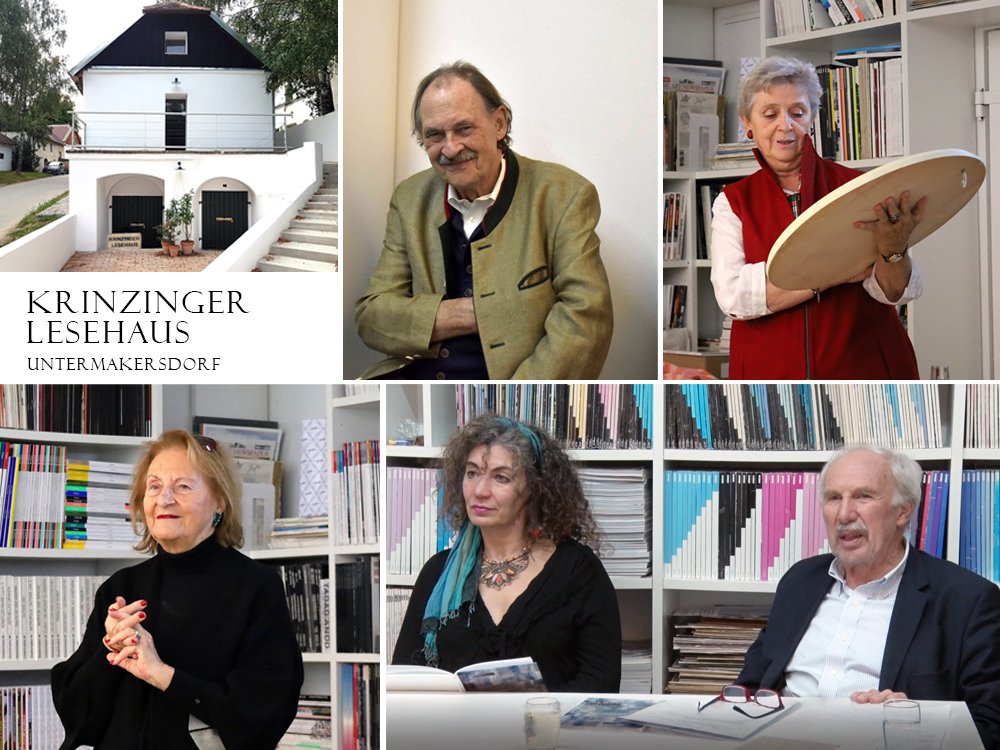
Above from left to right Hasso Böhme, picture: Romana Schuler Nön.at, Adelheid Hlawacek, picture. Krinzinger Lesehaus. Below from left to right: Ursula Krinzinger, Galerie Krinzinger, Martina Reinhart, Ewald Nowotny, picture: Krinzinger Lesehaus
Successful Struwwelpeter reading by Hasso Böhme with surprise guest Adelheid Hlawacek at the Krinzinger Lesehaus in Untermarkersdorf near Vienna on Sunday, 26 November 2023
From the article in the NÖN.at (Niederösterreichische Nachrichten) of 9 December 2023 by Romana Schuler:
Publisher Hasso Böhme and librarian Adelheid Hlawacek are “Struwwelpeter” experts. The two of them came to the Krinzinger Lesehaus in Untermarkersdorf to present the latest research findings on the world-famous children’s book to an interested audience. Hasso Böhme also owns the world’s most important and comprehensive private collection of Struwwelpeter books. “My collection of the various Struwwelpeter editions is 44 linear metres long“.
The stories about unruly children were written and illustrated by doctor Heinrich Hoffmann in 1844 as a Christmas present for his son. “Today, after almost 180 years, the stories have been translated into 60 languages, including Chinese, Japanese, Hebrew, Latin and even Esperanto,” says the expert.
The original manuscript entitled “Lustige Geschichten und drollige Bilder” was published in 1845 by Zacharias Löwenthal and Joseph Rütten in Frankfurt am Main.
In the current new publication “Der etwas andere Struwwelpeter”, Böhme, together with Alex Steiner, has integrated the Struwwelpeter stories into current events with satirical observations – such as Covid measures or the war in Ukraine.
Read the whole article (NÖN 49, 06.12.2023 – in German)
Researchers need a flair for criminology (Adelheid Hlawacek)
Adelheid Hlawacek presented a further research perspective on the cult figure of Struwwelpeter with the “Egyptian Struwwelpeter”, which was presented in Vienna in 1895 as a gift from three students of a friendly family to their host mother, inspired by an outstanding Egyptian exhibition in Vienna.
The librarian has been studying the subject for many years and is trying to shed light on this publication by the Viennese publisher Carl Gerold’s Sohn. Hlawacek explains the almost criminalistic procedure used to track down missing data.
In the second part of this inspiring reading event, the new book “Homages to Poets and Thinkers” by artist and philosopher Martina Reinhart was presented together with the former governor of the Austrian National Bank, Ewald Nowotny. In the joint presentation, Nowotny read an original text passage from some famous poets and thinkers, such as Didier Anzieu, Hafis or Artaud, and Reinhard presented her corresponding homage.
Many thanks to Ursula Krinzinger, Galerie Krinzinger and the Krinzinger Lesehaus team for organising and staging these remarkable readings.
December 21st 2023
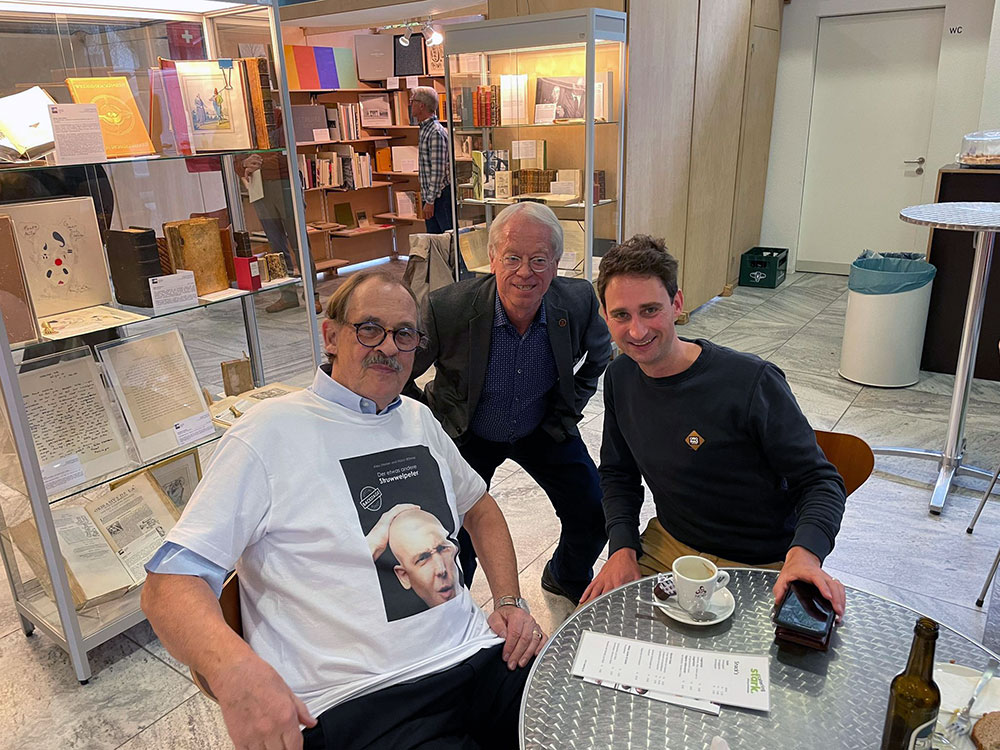
From left to right: Hasso Böhme, dohaböhme Vertrieb und Verlag AG, Marcus Benz, EOS Antiquariat Benz, Zurich, Dr. Peter Büttner, Heidiseum (The Heidi Heritage Project)
“Der etwas andere Struwwelpeter” aroused great interest at the Antiquarian Book Fair in Zurich from 04-06 November 2022.
The young publishing house dohaböhme Vertrieb und Verlag AG (company owner Hasso Böhme) aroused great interest at this year’s Antiquarian Book Fair from 04-06 November 2022 with the new publication of the book
- “Der etwas andere Struwwelpeter” (Alex Steiner and Hasso Böhme)
and the second edition of the book
- “Pedrito el Desgreñado” (Luis Rodriguez NOA)
have been able to attract a lot of attention. We are very happy about this!
The trilingual book “Pedrito el Desgreñado” (Spanish, German, English) was also awarded Book of the Month by the Swiss Bibliophile Society in August 2022. Read more.
Both books are available from us. Contact us at info@doha-bvv.com
Many thanks also to Marcus Benz (EOS Buchantiquariat Benz) for the space at the stand and in the showcase, where some more Struwwelpeter rarities from the collection of Hasso Böhme could be presented.
November 09th 2022
The “Twenty-Seventh”: Spectacular discovery of “Struwwelpeter” research
The first version designed by Heinrich Hoffmann reached 26 editions. From the 27th to and including the 30th edition, Hoffmann presented his second designed version of the fascinated children’s world. The original manuscript of this revision is kept in the Frankfurt University Library.
So far, there have been references to the 27th edition in the form of new announcements in other children’s books by Heinrich Hoffmann and a few press reviews referring to its appearance. A definitive, haptically tangible proof of the 27th edition had not been produced by the end of 2021. It was common practice in the publishing house to achieve a sales-promoting effect with new editions by changing the colour of the cover pages. Sometimes the differently coloured book covers were then pasted over with the new colour version. Thanks to many years of collecting activity and knowledge, restored book covers occasionally reveal interesting discoveries under the paste-overs.
This experience has been successfully used in the Struwwelpeter collection of the dohaböhme Research Library over the last 30 years. There, the autoptic examination of a 29th edition of Struwwelpeter from the Frankfurt University Library revealed that this copy not only had a slightly damaged binding, but even a different coloured binding could be seen underneath.
The author was able to encourage the library to examine the book and remove the cover with the numbering, 29th edition. Since the cover was in need of repair overall, the library decided to follow the suggestion. Everyone was curious to see what would be revealed. Will a colour variant of the 29th edition or even another edition appear? To great delight, the restorers of the university library discovered an original cover of the 27th edition. At last there is proof that the 27th edition was actually published.
Read the whole report of the Goethe University Frankfurt a.M. in German.
July 18th 2022
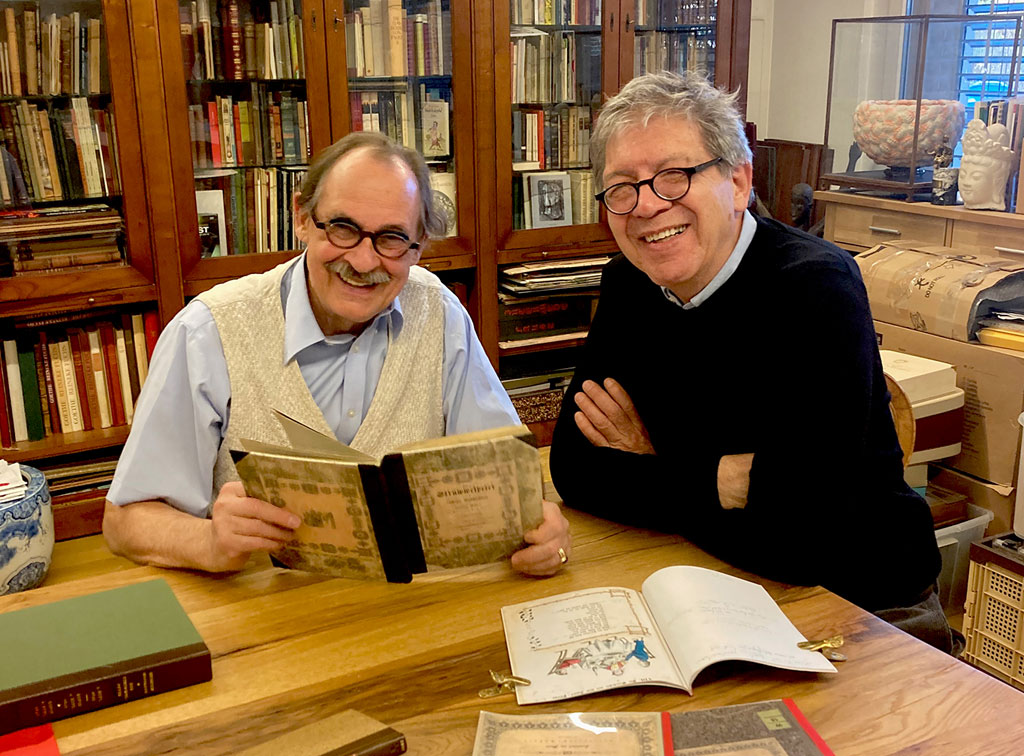
From left to right: Hasso Böhme and Prof. Dr. Alfred Messerli with a fragment of a 5th edition of “Struwwelpeter” compared to previous and later editions.
Visit to the dohaböhme library & archive.
On Wednesday, 23 February 2022, library owner Hasso Böhme was pleased to welcome
- Prof. Dr. Alfred Messerli, former Professor of Popular Literatures and Media at ISEK, University of Zurich
to Unterengstringen. Alfred Messerli was interested in the main topics and the related research directions of the dohaböhme library.
Alfred Messerli’s research focuses on narrative research, self-testimonies, mass image research, children’s folklore and reader research.
Hasso Böhme and Alfred Messerli devoted this afternoon, among other exciting topics, to the examination of a successfully completed research project based on a fragment of a 5th Struwwelpeter edition in comparison to the 3rd and 4th, as well as the 6th edition.
An interesting exchange of experiences took place on the use of Excel files for recording and processing book collections. The discussion will be continued.
February 28th 2022
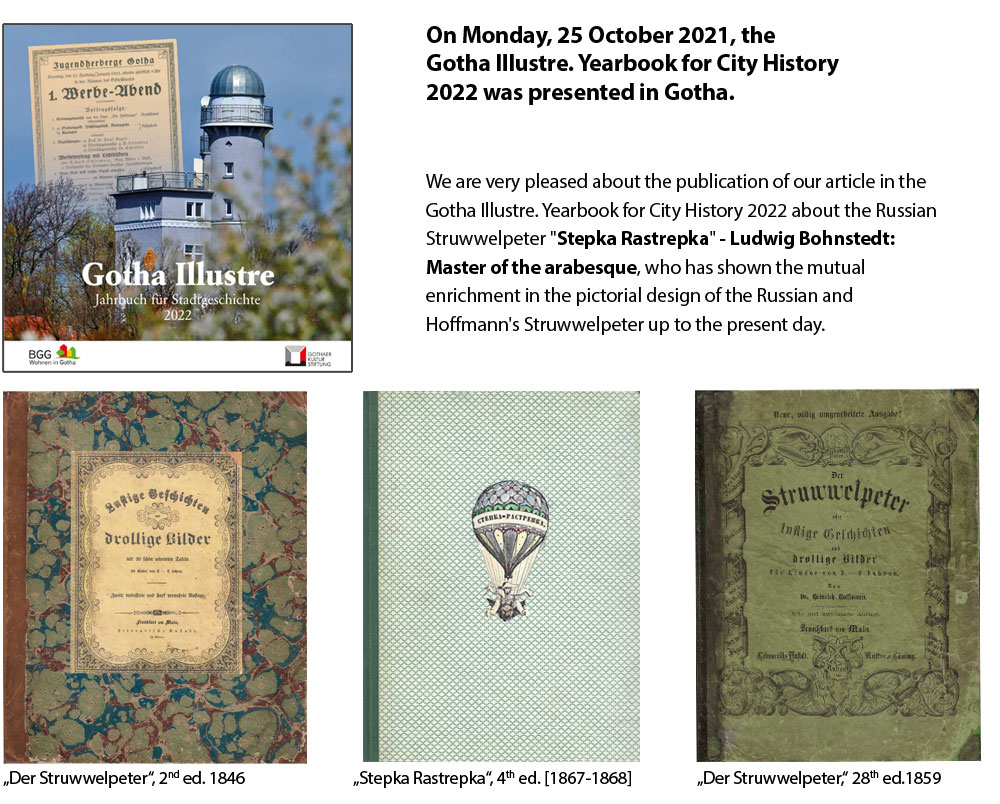
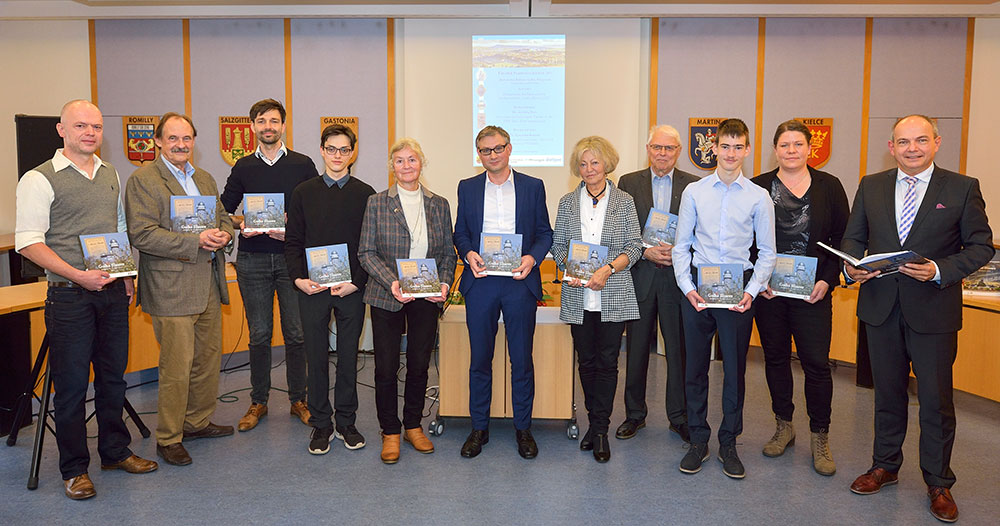
The authors of the Gotha Illustre Yearbook. From left to right: Matthias Rekow, Hasso Böhme, Christoph Mauny (Stiftung Schloss Friedenstein i.V. for Alexander Kluge), Christopher Ludwig, Ines Frels, Alexander Krünes (City Historian of Gotha), Gisa Steguweit, Wolfgang Steguweit, Richard Wiegand, Julia Beez, Knut Kreuch (Lord Mayor of Gotha). Photo: Lutz Ebhardt, Gotha
Gotha Illustre. Yearbook for City History 2022 was presented on Monday, 25 October 2021 in the Bürgersaal of the Historisches Rathaus in Gotha.
Lord Mayor Knut Kreuch presented the new “Gotha Illustre”, Yearbook for City History 2022 to the public on 25 October 2021, together with city historian Dr. Alexander Krünes and the authors and sponsors. This is now the fifth volume of the yearbook, which was redesigned in 2017 and takes a closer look at various aspects of Gotha’s city history.
For this edition, the dohaböhme blibliothek & archiv (Hasso Böhme) contributed an article: “Stepka Rastrepka” – Ludwig Bohnstedt: Master of the Arabesque. In this article, Ludwig Bohnstedt is described on the one hand as an architect who lived in Gotha from 1862 until his death in 1885. As an architect, he designed and created numerous private and representative buildings in Gotha and won numerous tenders, which he was then able to realise architecturally. On the other hand, it is less well known that an early collaboration between the publisher Moritz Ossipowitsch Wolff, Ludwig Bohnstedt and the illustrator Georgy Vasiljevich Hohenfelden from 1848 onwards resulted in one of the most beautiful Russian Struwwelpeter children’s books, “Stepka Rastrepka”. Ludwig Bohnstedt’s arabesques behave as a kind of complementary commentary to the text and picture. They playfully take up the theme of the stories and guide the viewer through the story. The article compares four stories as well as the inside title page of the three editions: “Der Struwwelpeter” – 2nd edition 1846, “Stepka Rastrepka” – 1st or 4th edition [1867-1868] and “Der Struwwelpeter” – 28th edition 1859, where the mutual enrichment in the pictorial design between Hoffmann’s Struwwelpeter and the Russian Struwwelpeter “Stepka Rastrepka” can be traced up to the present day.
Incidentally, the three protagonists proved to be extremely successful in their later professional lives: Ludwig Bohnstedt received the first prize for the best design of the new Reichstag building in Berlin in 1871/72. Georgy Vasiljevich Hohenfelden became one of the most important engravers and printers in Russia. Moritz Ossipowitsch Wolff was even called the “Tsar of Books” during his lifetime.
Gotha Illustre. Yearbook for City History 2022 (Only available in German: Gotha Illustre. Jahrbuch für Stadtgeschichte 2022) can be obtained from the shop “Gotha adelt – Tourist-Information & Shop”:
Gotha adelt – Tourist-Information & Shop
Hauptmarkt 40, DE-99867 Gotha
Phone: +49 3621 510 440
E-Mail: laden[at]gotha-adelt.de
Please note that this article may not be published commercially and may only be used for internal purposes.
Updated 03 February 2022
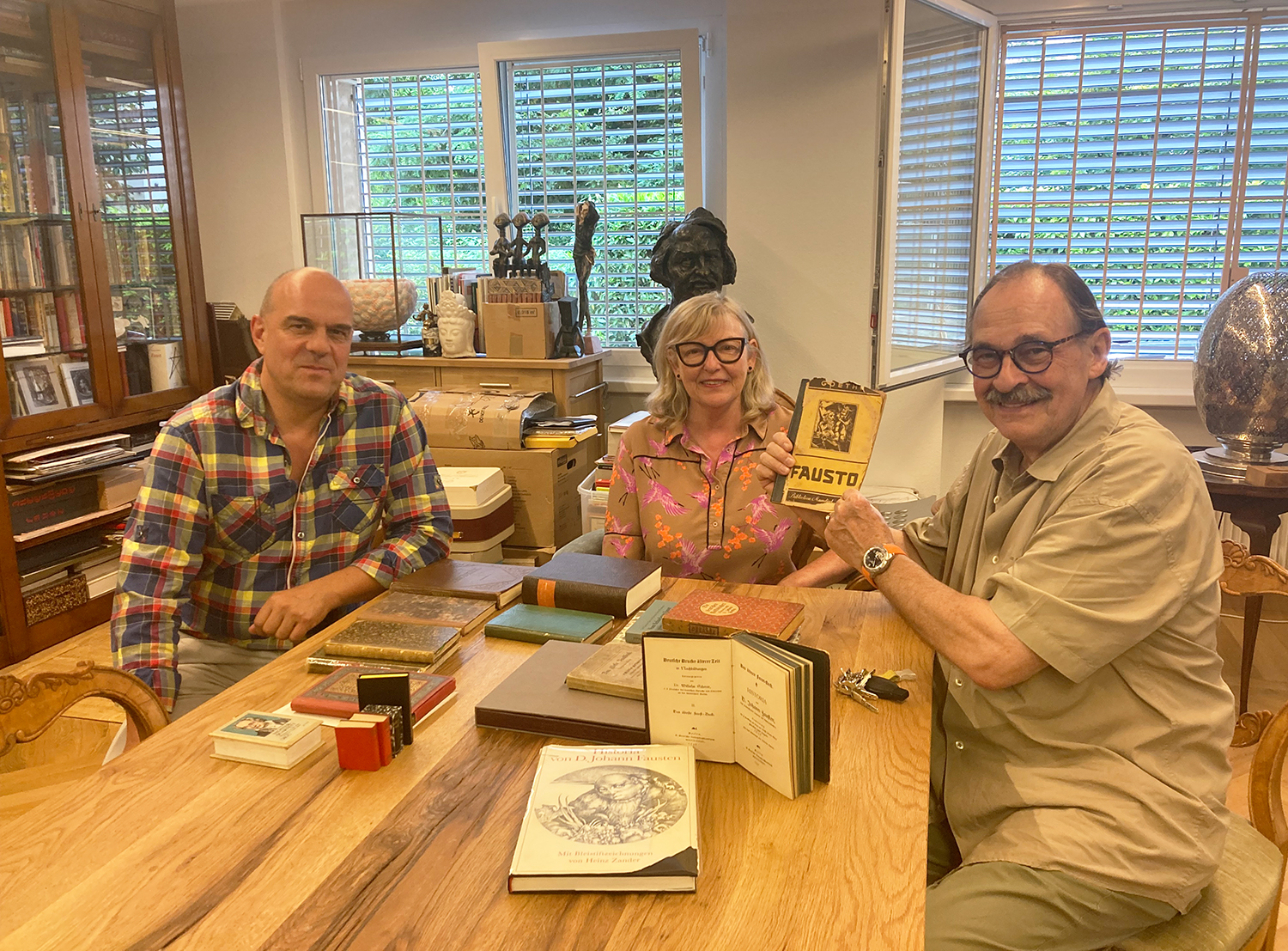
From left to right: Prof. Dr. Andreas Kilcher, Dominique and Hasso Böhme
Visit to the dohaböhme library & archive
On Wednesday, 15 September 2021, library owners Dominique and Hasso Böhme were pleased to welcome,
- Prof. Dr. Andreas Kilcher, Professor of Literature and Cultural Studies (ETH Zurich)
in the dohaböhme library in Unterengstringen.
On one hand, Andreas Kilcher’s work is dedicated to the connection between literature and knowledge, which he demonstrates in particular in the two subject areas of encyclopaedias as well as esotericism. With regard to esotericism, it is above all works on the Kabbalah and modern occultism. Secondly, his works deal with the history of Jewish literature as well as Jewish culture in Europe, especially in Germany.
During Andreas Kilcher’s visit, topics such as “Faust” and the history of the “Hebrew Struwwelpeter” were discussed in detail and we are very pleased to have Andreas Kilcher as an extremely well-founded advisor for our future research work in the field of “Struwwelpeter’s Hebrew Mischpoke”.
September 21st 2021
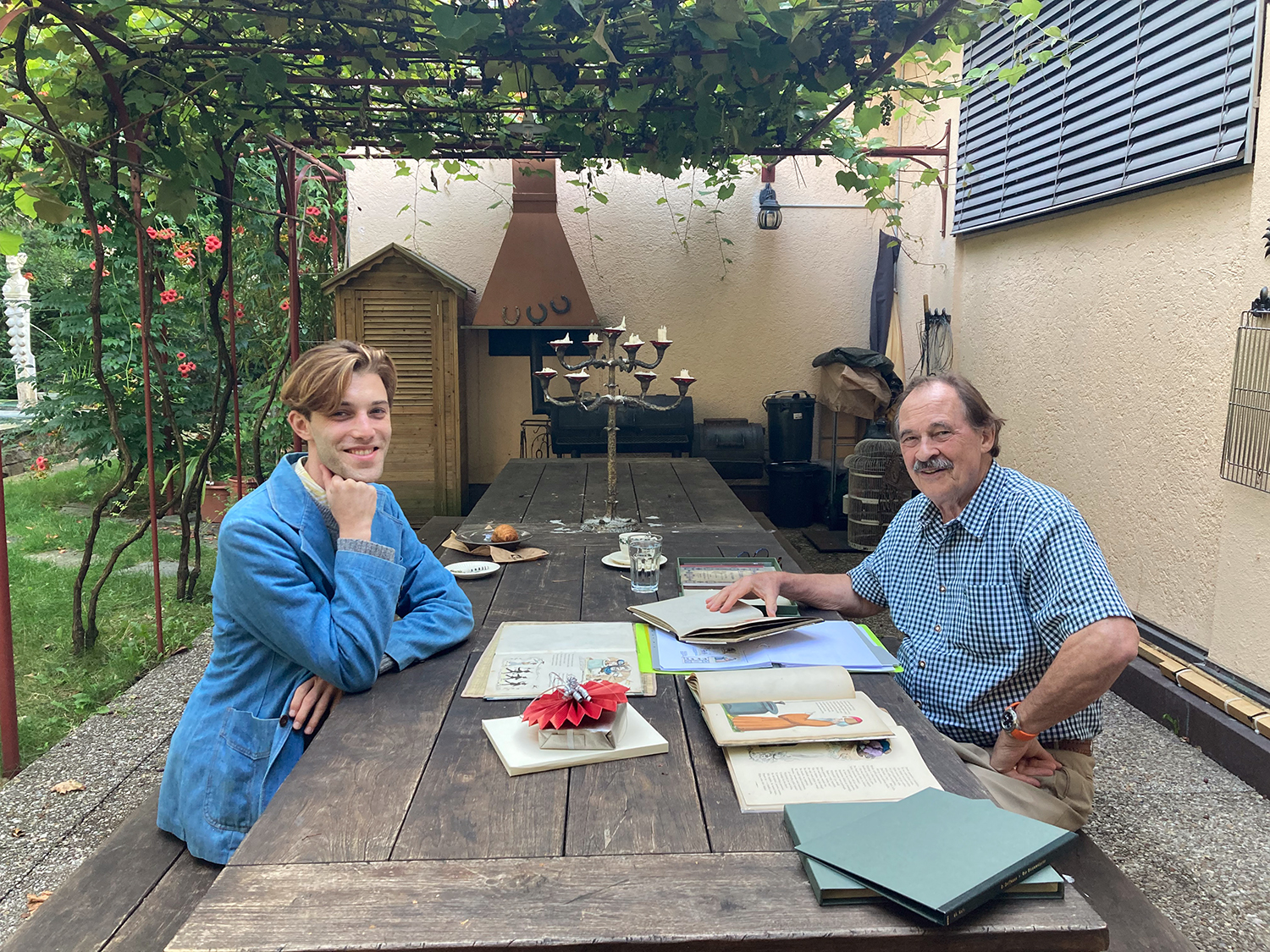
From left to right: Niv Fridman and Hasso Böhme
Visit to the dohaböhme library & archive
On Wednesday, 25 August 2021, library owner Hasso Böhme received an exciting visit from Israel (Tel-Aviv):
- Niv Fridman
Niv Fridman is a BFA graduate from Bezalel. He has exhibited his work at New Gallery Artists’ Studios Teddy, Hecht Museum, Israel Museum and Cuckoo’s Nest and presented his video work at the Tel Aviv International LGBT Film Festival and the Beer Sheva Short Film Festival. He is the winner of several academic excellence awards, photography and music video competitions and the ARTiq scholarship.
A few years ago, Niv Fridman illustrated and wrote a short story called “The Chocolate Girl” – ילדה שוקולדה, inspired by a story told by his mother and the German children’s book Struwwelpeter by Heinrich Hoffmann (or in Hebrew: יהושע הפרוע).
This resulted in a book “Struwwelpeter in Israel”, with four impressive stories with a clear moral message about the consequences of misbehaviour. The book also contains 21 hand-drawn illustrations, which the artist later digitised. We are proud to have this unique piece in our collection.
September 7th 2021
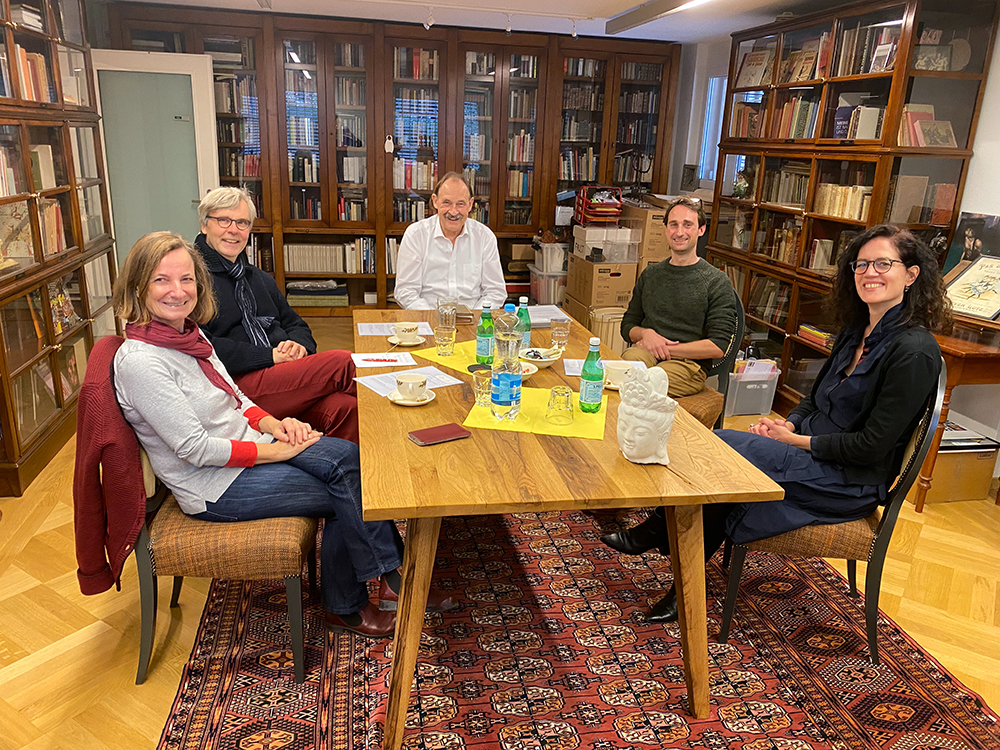
From left to right: Gudrun Zimmermann, Prof. Dr. Harm-Peer Zimmermann, Hasso Böhme, Dr. Peter Büttner, Prof. Dr. Christine Lötscher
Visit to the dohaböhme library & archive
To our great pleasure, library owner Hasso Böhme and Dr. Peter Büttner very pleased to welcome the following selected guests on Monday, 12 October 2020:
- Prof. Dr. Christine Lötscher, ISEK University of Zurich
- Prof. Dr. Harm-Peer Zimmermann, ISEK University of Zurich
- Mrs Gudrun Zimmermann
The guests were able to gain a well-founded insight into the work in the research library dohaböhme in Unterengstringen.
We are very grateful for the stimulating discussions about the five Heinrich Hoffmann children’s books at a glance, the Struwwelpeter, early rare foreign-language Struwwelpeter editions, the planned bibliography of Hebrew Struwwelpeter editions, Struwwelpeter rarities, furthermore about the collection “Reineke Fuchs” – fables and rare early modern prints from 1538 until today, as well as the extensive collection “Faust”.
October 19th 2020
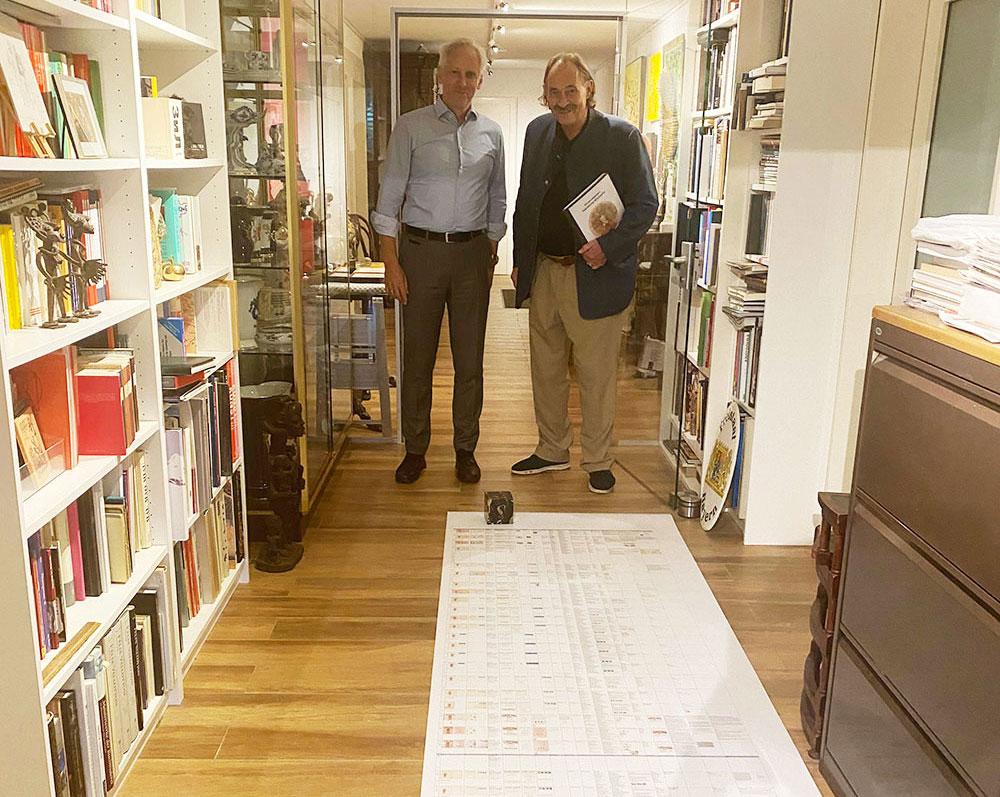
Prof. Dr. Gerhard Lauer and Hasso Böhme in front of the Hebrew “Floorpaper-Carpet (approx. 0.85 m x 4.50 m)
Visit of Prof. Dr. Gerhard Lauer in the dohaböhme library & archive
On Wednesday, 2 September 2020, we were pleased to welcome Prof. Dr. Gerhard Lauer from the University Basel to our research library.
The following topics were lively discussed and looked at:
- Hebrew Struwwelpeter editions and books (including “Floorpaper-Carpet”)
- Donald Brinkman – Psychoanalysis about the Struwwelpeter
- First proven Danish Struwwelpeter edition “Vær lydig” from 1847
- Dedicated copies and special original documents
- Collection “Faust”
- Various other topics
We are very grateful for this inspired and beautiful afternoon.
October 29th 2020
“Struwwelpeter’s Hebrew clan” (German report)
Aus dem Antiquariat (German), September issue 2020 – Report: dohaböhme library & archive
September 28th 2020
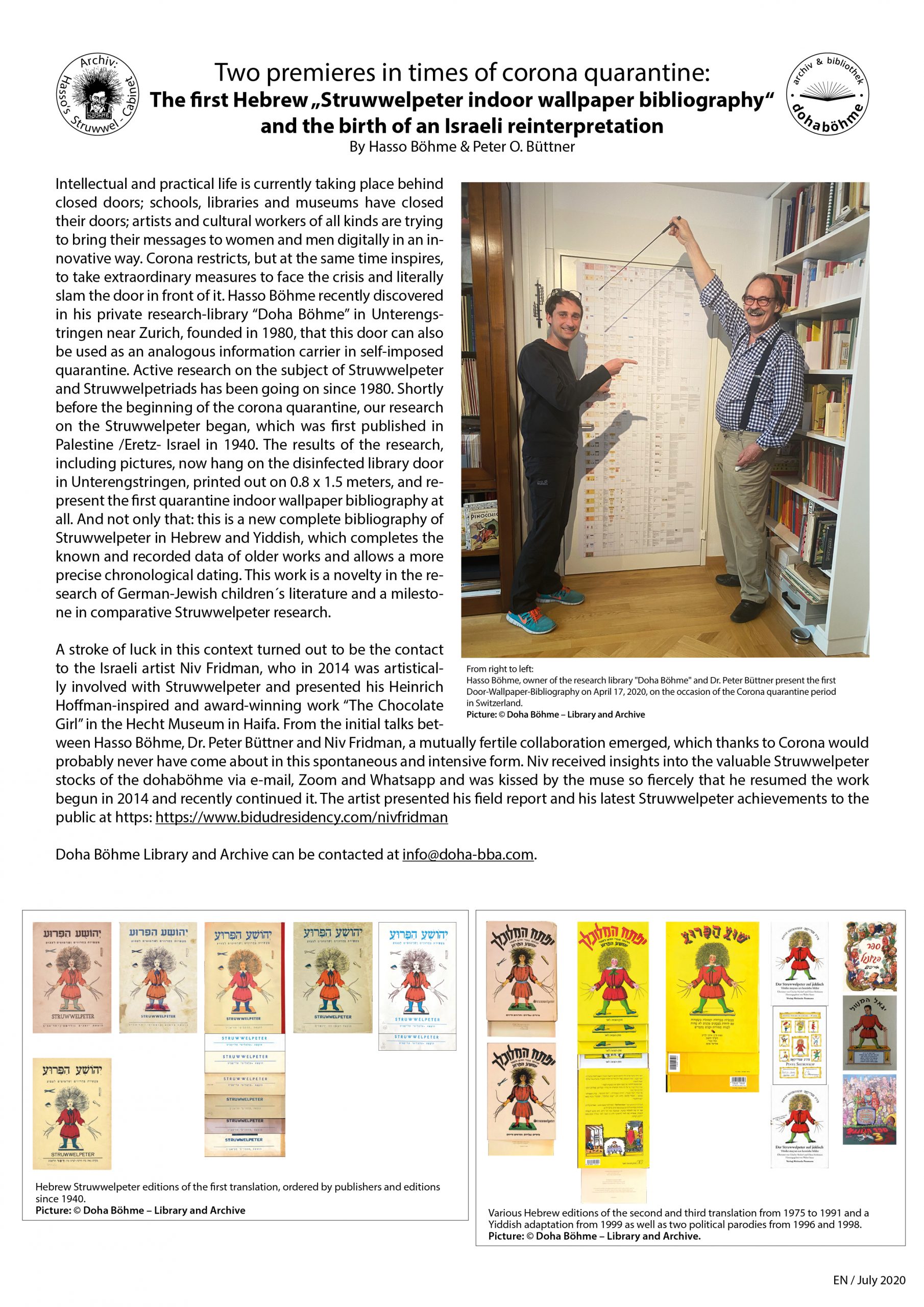
PDF DOWNLOAD: First hebrew Struwwelpeter indoor wallpaper bibliography
Door-Wallpaper-Bibliography of the Hebrew Struwwelpeter variants published since 1940
The “Doha Böhme” in Unterengstringen near Zurich is a private research library in the field of historical children’s literature. Other areas of collection include Faust, Reineke Fuchs, fables and ABC books. The collection size amounts to approximately 8,000 objects.
A special focus of the library is on the literary life’s work of Heinrich Hoffmann, the creator of Struwwelpeter. The collection includes not only valuable original editions in various languages, but also manuscripts and documents dealing with the history of Heinrich Hoffmann’s children’s books.
The scope of the “Struwwelpeter & Struwwelpetriaden” collection is impressively reflected in the two-volume bibliography “Böse Kinder” (Evil Children) written by Reiner Rühle. Hasso Böhme, founder and owner of “Doha Böhme”, has not only supported Reiner Rühle in his research work for over thirty years, but also maintains intensive contacts with university institutions, research facilities, libraries and museums.
In the working group around Dr. Peter Büttner, Nurit Blatman, Nathalie Gacond (graphic design) and Hasso Böhme, the history of the Hebrew Struwwelpeter from 1940 to the present day has been largely worked out.
A total of three Hebrew and one Yiddish translations were found as well as parodies of the famous Israeli comic illustrator Uri Fink. The first translation was published in 1940 under the title “Yehoshua haparua” by Joachim Goldstein in Tel Aviv. He gave the initials “L. Z.” as the translator. As Itamar Levy, a renowned antiquarian and book researcher in Tel Aviv in 2011 stated, everything indicates that behind “L. Z.” there is the famous Lili Zadek. The second translation was done by Uri Sela in 1975 and a third one by Uriel Ofek in 1985. These translations are already characterized by an advanced modern Hebrew.
The drawings and texts originally created by Heinrich Hoffmann (1844) for his three-year-old son, which presented themselves to young people through simplicity, fearlessness and clarity, proved to be immortal. In the mirror of their contemplation over time, they found a remarkable positive response in later reviews such as those by Max Brod and Uri Blum (1940), as well as in the blurb by Uriel Ofek (1991). As Peter von Matt, professor emeritus of literature from Zurich, also notes in his Reclam booklet (2009) about the Struwwelpeter at the end: “The book made its career through the will of the children. They said yes to the book […]. The jubilation of the children and the desire of the market left the horrified parents, the shocked educators and all the other called and uncalled protectors of the children’s soul helpless.”
The results are presented in a corona inspired door-wallpaper bibliography on 0.85 x 1.50 m and the project is described in a small press release on the occasion of the current situation
April 29th 2019
Our books:
Available at dohaböhme Vertrieb und Verlag AG:
“Der etwas andere Struwwelpeter – Special Backstage Edition” | ISBN: 978-3-033-09175-7
“Pedrito el Desgreñado” 2nd edition | ISBN: 978-3-00-062705-7
“Doktor Faust und Struwwelpeter” | ISBN: 3-9803612-9-2 | NEW: 978-3-033-09607-3
“150 Jahre Struwwelpeter” | ISBN: 3-907960-71-8 | NEW: 978-3-033-09606-6
You can also contact us for orders at info@doha-bvv.com
All books are available.
 Der etwas andere Struwwelpeter (A. Steiner and H. Böhme) – Special Backstage Edition
Der etwas andere Struwwelpeter (A. Steiner and H. Böhme) – Special Backstage Edition
ISBN 978-3-033-09175-7, dohaböhme Vertrieb und Verlag AG
Alex Steiner offers his friend Hasso Böhme, owner of one of the most important Struwwelpeter collections, a poem for his birthday. The poem develops into „Der etwas andere Struwwelpeter“ („The somewhat different Struwwelpeter“), in which Monty Python, Trump, Musk, Putin and other protagonists all make an appearance.
In a new, colourful graphic design, Alex and Hasso guide the reader through twelve satirical and thoughtful reflections on today‘s cultures, completely in the spirit of the political Struwwelpeter tradition and its values since 1849.
The book contains 12 stories on current events as well as a bibliography of the political Struwwelpetriads since 1849 until today. This is a numbered special edition, which includes an additional eight-page thematic supplement whose contents are “praised” by Struwwelpeter. Book only available in German.
The book is offered through the self-publishing company dohaböhme Vertrieb und Verlag AG. For orders with the addition “Special Backstage Edition” contact us at info@doha-bvv.com
Comments:
“… Thanks for this very special book, full of wit and wisdom.” Prof. Dr. Andreas Kilcher, ETH Zurich
“… When I first got my hands on “the” classic Struwwelpeter as a small child, it was the drawings that fascinated me. After losing sight of it, Struwwelpeter caught up with me again when I was not only able to read the rhymes with difficulty, but also understood them to some extent… Having lost sight of it again, the book caught up with me again when I got to know Hasso Boehme as a distinguished connoisseur and collector of the most varied Struwwelpeter editions. Finally, the surprise: Struwwelpeter is alive! As a new and very inventive new publication. The themes have changed, the style of the rhymes hardly. From this point of view, there can always be “updated” editions. Great compliments and thanks to Hasso Boehme and Alex Steiner for this very successful experiment!” Fred Maro, www.fredmaro-group.net
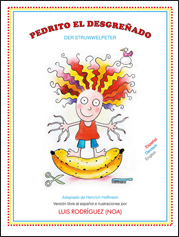 Pedrito el Desgreñado by Luis Rodriguez (NOA) 2nd edition
Pedrito el Desgreñado by Luis Rodriguez (NOA) 2nd edition
ISBN 978-3-00-062705-7, dohaböhme Vertrieb und Verlag AG
With wit and skill, Cuban artist Luis Rodríguez (NOA) has created a contemporary Struwwelpeter reinterpretation for Cuban children in a new guise. Pedrito“ stands surfing on a banana and gazes merrily out into the world. A special feature of this children‘s book is its trilingualism: Cuban, German – with the original pictures and texts by Heinrich Hoffmann and the American interpretation by Mark Twain.
The book is offered through the self-publishing company dohaböhme Vertrieb und Verlag AG.
For orders contact us at info@doha-bvv.com
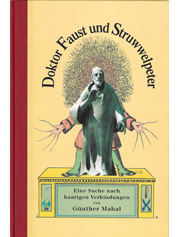 Doktor Faust und Struwwelpeter – eine Suche nach haarigen Verbindungen by Günther Mahal
Doktor Faust und Struwwelpeter – eine Suche nach haarigen Verbindungen by Günther Mahal
ISBN: 3-9803612-9-2, previously Windrose Verlag, Kieselbronn | NEW: ISBN 978-3-033-09607-3 dohaböhme Vertrieb und Verlag AG
It is well known that „Faust“ and „Struwwelpeter“ were written by two Frankfurt authors. Whether there are other, more than hair-thin connections between the devil-may-care doctor, and the still beloved rebellious fuzzy head with overlong fingernails, this book explores this question in an interesting way, and with a wealth of pictorial examples of long-haired and non-haired contemporaries far removed from all Germanist piety.
Book only available in German.
The book is offered through the self-publishing company dohaböhme Vertrieb und Verlag AG.
For orders contact us at info@doha-bvv.com
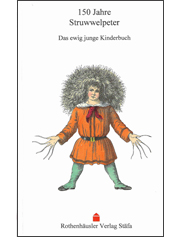 150 Jahre Struwwelpeter – Das ewig junge Kinderbuch
150 Jahre Struwwelpeter – Das ewig junge Kinderbuch
ISBN: 3-907960-71-8, previously Rothenhäusler Verlag, Stäfa | NEW: ISBN 978-3-033-09606-6 dohaböhme Vertrieb und Verlag AG
In October 1845, the picture book Struwwelpeter. Pretty Stories and Funny Pictures by the Frankfurt doctor Heinrich Hoffmann. The first edition was sold out in four weeks. 150 years later, the multilingual rascal remains a long seller and bestseller without precedent, a cosmopolitan cult figure. On the occasion of his 150th birthday, this original Struwwelpeter is published for young and old. An interesting reference book for those interested in the history of Struwwelpeter.
Book only available in German.
The book is offered through the self-publishing company dohaböhme Vertrieb und Verlag AG.
For orders contact us at info@doha-bvv.com
First publication of a Cuban-spanish Struwwelpeter:
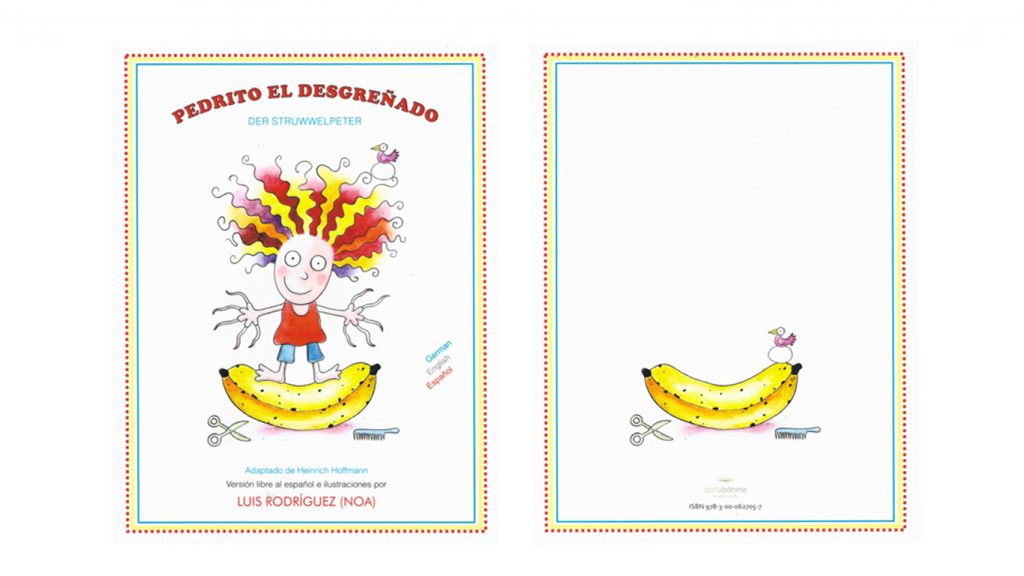
The Struwwelpeter-Museum in Frankfurt
was able to present the honoured Cuban artist
Luis Rodriguez NOA for a demanding special exhibition, to be seen
in Frankfurt from 24 October 2019 until summer 2021 under the title
The Cuban «Pedrito el Desgreñado»
Pedrito el Desgreñado:
Pedrito el desgreñado. Adaptado de Heinrich Hoffmann. Versión libre al español e ilustracones por LUIS RODRÍGUEZ (NOA), (with original text by Heinrich Hoffmann, German, Mark Twain, English).
ISBN: 978-3-00-062705-7, limited edition in 215 signed copies, La Habana, Cuba: Ediciones NOA-ART & dohaböhme library & archive (first edition sold out, 2nd edition available).
Memberships:
